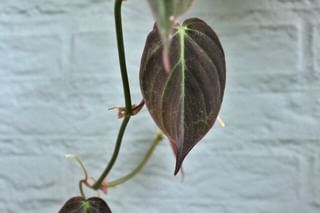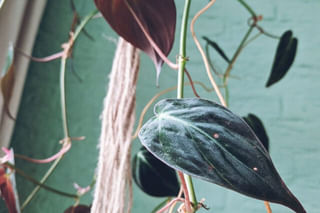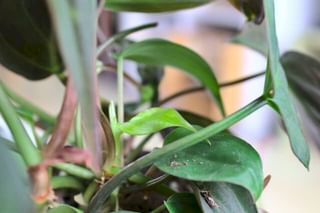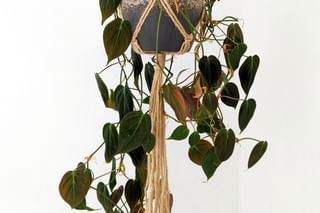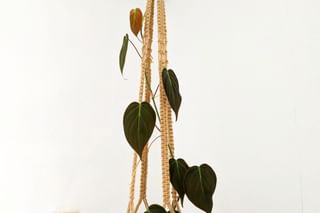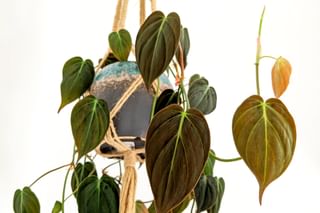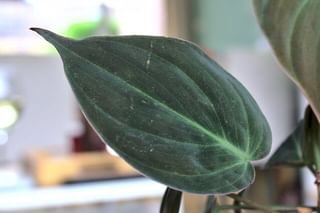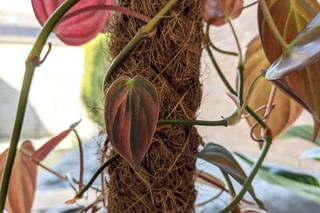How to care for a Philodendron
Philodendrons are beautiful plants that grow vines with heart-shaped leaves. In this guide, we'll go over how you can take care of a Philodendron plant yourself and help it to grow and thrive.
Philodendrons are beautiful plants that grow vines with heart-shaped leaves. It's a strikingly beautiful plant that stands out in any room of your house. In this guide, we'll go over how you can take care of a Philodendron plant yourself and help it to grow and thrive. They're quite easy-going and quick-growing plants, which makes them perfect for beginning plant owners.
In this guide, we'll go over these topics:
Let's learn how to take care of a Philodendron indoors!
Light exposure for a Philodendron
Your philodendron is a versatile plant because it can thrive in varying light levels. However, the perfect light for the philodendron should resemble the light exposure it gets in nature: bright and indirect sunlight. As the Philodendron has vines and likes to climb, it grows on tree trunks, in shaded areas. In nature, it rarely gets direct sunlight, so this is something you should avoid for your houseplant as well.
Yellow leaves on your philodendron
When your philodendron is getting many yellow leaves at once, it might be getting too much sunlight. If it's just 1 or 2 leaves, you have nothing to worry about. Old leaves on a Philodendron turn yellow, so this is a natural process.
Too little light exposure
When your philodendron gets too little light, its aerial roots or vines will stretch and there will be a lot of space between individual leaves. It does this to reach for the light like a succulent would when it's not getting enough of it. So when you see this happening, it's time to find a brighter spot for your philodendron.
Once your plant starts to slow its aerial root growth and the leaves are growing closer together, it's getting the proper amount of light. You can always use a grow light to supplement the lack of light in darker areas of your house.
Watering a Philodendron
Watering your philodendron is quite simple: let the top of the soil dry out between waterings. However, don't let more of it dry out as philodendrons grow quite quickly. When they're growing quickly, they like to absorb a lot of moisture from the soil.
Make sure you're using a pot with drainage holes, to make sure the soil isn't wet and any excess water can escape from the bottom of the pot. This will keep your plant happy.
Drooping leaves
When your philodendron starts to droop, it usually indicates a watering issue. It could mean that your plant is getting too much water or not enough. It's easy to discover which one it is because if the soil is dry, the plant needs more water and if it's wet you need to let it dry out. The leaves will go back to normal when you've corrected the watering issue.
Dealing with root rot
Root rot is a common issue in Philodendrons, especially when overwatered. If you want to prevent root rot, make sure to not overwater your plant and let the soil dry out between watering. You can also use a well-draining soil mix that will prevent waterlogging. If the soil seems wet or the leaves start to droop, refrain from watering for a while.
If your plant has already been affected by root rot, don't worry, it can still be treated. First, remove the plant from the pot and examine the root system. If most of the roots are brown and mushy, it might be time to trim them with sterilized shears (or scissors) and repot the plant in fresh soil. Make sure the pot has a drainage hole as well.
After repotting, water the plant lightly and keep an eye out for any changes in the leaves. It's normal to see some wilting after repotting but if the leaves continue to droop, the root rot might have been too far gone, and it might be best to propagate your plant from cuttings. Remember, prevention is always better than cure when it comes to root rot.
Temperature and humidity requirements
It's worth noting that Philodendrons make fantastic houseplants, thanks to their resilience and ease of care. With that said the temperature in which they thrive varies, depending on the type.
For example, many Philodendrons grow well in temperatures that range between 18 to 27 degrees Celsius (65 to 80 F). It's important to keep the plant in a room that's consistently warm, away from cold or hot drafts, such as air conditioning or open windows. These extreme temperature changes can shock your plant and kill it.
When it comes to humidity, Philodendrons love a medium level of humidity. A humidifier will be a useful tool to help the plant stay happy. Aim for humidity levels that range between 40% to 60%. You can achieve this by misting the leaves regularly or placing the plant on a tray of pebbles filled with water, which will create an ideal level of humidity.
Quick growers
Philodendron plants are very quick-growing plants. Its vines can grow up to 10 cm (3.9 in) per week if it's in the growing season. While growing its vines, it'll also start to grow leaves and aerial roots along with those vines. If you don't control this growth the vines will be all around your living space in a very short time. When it gets too large, you can propagate the vines and grow more philodendrons.
To promote new growth on a philodendron, it's always a good idea to trim the vines and propagate those, only to then grow it with the parent plant again. This will grow new vines and will give you a fuller plant over time.
Fertilizing a Philodendron
As Philodendrons are fast-growing plants, they need regular fertilizing. They'll need all the energy they can get to keep growing as quickly as possible. When you see your plant starts to grow more slowly, this could mean that it used all the fertilizer and it's time to give it some more.
During the growing season, spring and summer, it's best to fertilize the philodendron once per month. During the dormancy period, autumn (fall) and winter, you can scale this back to once per 6 to 8 weeks.
Soil for a Philodendron
Philodendrons are quite thirsty plants, but also can't sit in wet soil for too long. So it's good to get soil that retains water for a longer time but drains all excess moisture and doesn't compact when it's moist for a long time. A palm soil mix is a great choice for a philodendron. It can retain water well but doesn't compact, which allows oxygen to get to the roots at all times.
Repotting a Philodendron
Philodendrons are beautiful plants that are quite easy to care for. They can be grown indoors and outdoors, they require a pot with good drainage and good aeration. As they grow, Philodendrons often outgrow their pots, and this is when it becomes necessary to repot them.
Some signs that mean it's time to repot your Philodendron include roots growing out of the bottom of the pot, slow growth, and soil that dries out quickly after watering. Ideally, you should repot your Philodendron once every two years, or when the plant has outgrown its current container.
To repot a Philodendron, start by selecting a container that's one size larger than the current one. Make sure the new pot has drainage holes to prevent water from collecting at the bottom and causing root rot. Next, prepare the soil, which can be a mixture of potting soil, perlite, and peat moss. Fill the bottom of the new pot with a layer of fresh soil, about two to three inches deep.
Gently remove your Philodendron from its current pot, being careful not to damage the roots. Use your fingers to loosen any tangled roots, and trim off any dead roots. Place the plant in the center of the new pot and fill in the sides with the remaining soil. Make sure to leave some space between the soil level and the rim of the pot to avoid overflow during watering.
Water the plant thoroughly to help settle the soil, and place it in a location with indirect sunlight for a few days to help it adjust to its new container. Be sure to keep the soil moist but not waterlogged, and monitor the plant closely for any signs of stress or disease.
Repotting your Philodendron will help promote healthy growth, ensure proper drainage, and prevent root binding.
Propagating a Philodendron

Propagating Philodendrons from cuttings is a great way to expand your collection or share the plant with friends. Here's how to do it:
- Choose a healthy Philodendron stem to cut. Look for one that has a few leaves and a node (a small bump where the leaf attaches to the stem).
- Use sharp, clean shears to make a clean cut below the node. You can also remove the lower leaves to create more space for roots to grow.
- Dip the cut end into rooting hormone powder (this is optional, but it can help speed up the root growth process).
- Place the cutting in a small pot or jar filled with moist potting soil. Cover the top of the pot or jar with a plastic bag to create a mini greenhouse.
- Keep the soil moist but not waterlogged, and place the pot or jar in a warm, brightly-lit spot but not in direct sunlight. A humidity-boosting pebble tray can also help.
- After a few weeks, gently tug on the cutting. If you feel resistance, roots have started to form! Continue caring for the cutting as you would a young Philodendron plant, gradually removing the plastic bag as it grows.
Remember, not every cutting will be successful - but don't give up! Experiment and try different techniques until you find the one that works best for you and your Philodendrons.
Pruning a Pholdendron
Pruning your Philodendron is essential to promote healthy growth and maintain its shape. You should prune your plant during its active growing season, which typically falls between spring and summer.
To help you get started, here are some general tips for pruning your Philodendron:
- Identify the areas that need to be pruned: Inspect the plant and identify any yellow or brown leaves, leggy stems, or branches that are growing out of control.
- Use sharp, sterilized pruning shears: This will help prevent the spread of diseases and ensure clean cuts that promote healing.
- Cut back to a leaf node: To encourage bushier growth, trim back the stems just above a healthy leaf node. New growth will emerge from this node, giving your plant a fuller appearance.
- Keep the plant balanced: When cutting back stems and branches, it's important to maintain a balanced appearance. This will help make sure that your Philodendron continues to grow evenly in all directions.
Remember, pruning can be intimidating, but don't be afraid to give it a try. With a little practice, you'll become an expert at keeping your Philodendron happy and healthy.
Pruning brown and dead leaves
Removing brown or dead leaves from your Philodendron is important to keep it healthy and promote new growth. Dead or decaying leaves can attract pests and diseases that can harm the entire plant.
To remove dead or brown leaves, simply use sharp, clean scissors or pruning shears to cut them off at the base where they connect to the stem. Be sure to cut as close to the stem as possible without damaging any healthy leaves or stems. You can also gently pull the leaves away from the stem with your fingers if they are easy to remove.
It's also important to regularly inspect your Philodendron for any signs of disease or pests, such as yellowing leaves or spots on the foliage. If you notice any issues, treat them promptly to prevent further damage to your plant.
Reviving a wilting Philodendron
If your Philodendron is wilting, it could be due to a variety of reasons such as over-watering, under-watering, low humidity, lack of nutrients or light. However, there are some simple steps you can take to revive your plant.
Check the moisture level
First, check the soil moisture by sticking your finger about an inch into the soil. If it feels dry, it's time to water your plant. However, if the soil still feels moist, then wait a day or two before watering again to avoid over-watering.
Check the sunlight
Make sure that your plant is getting enough light. Philodendrons prefer bright but indirect light. If your plant is not receiving enough light, consider moving it to a brighter spot. You can also use a grow light if your home does not have enough natural light.
Consider the humidity levels in the room. Philodendrons thrive in high-humidity environments, so you can increase the humidity by placing a tray of water near the plant or using a humidifier.
Fertilize your Philodendron
If you suspect that your Philodendron is lacking nutrients, consider feeding it with a balanced fertilizer. However, it's important to follow the instructions on the fertilizer package as over-fertilizing can harm your plant.
Prune any damaged or dead leaves to allow your plant to direct its energy toward healing and developing healthy new growth.
Philodendrons are hardy plants, and with proper care, your plant will be back to its lush, vibrant self in no time. So, don't give up on your plant just yet, try these tips, and you'll soon see it thriving again!
Poisonous
Unfortunately, philodendrons could be harmful to your cats and dogs. When your cat or dog chews on philodendrons, it could cause hypersalivation, abdominal pain, vomiting, swelling of the pharynx, and difficulty swallowing.
When you notice any of these symptoms after your pet has chewed on a philodendron, you should contact your vet to help your pet. To avoid this situation altogether, put your plant in a place where your pets can't reach the plant, and be sure to trim your plant before its vines can grow long enough for your pets to reach it.
Pest Control
When it comes to Philodendrons, several pests can become a problem for your plants. Some of the most common ones include spider mites, mealybugs, scale insects, and thrips. These pests can cause damage to the leaves, stems, and roots of your Philodendrons, and if left untreated, can even kill your plants. So, what can you do to naturally get rid of these pests?
Use neem oil to control pests
One method is to use neem oil, which is a natural insecticide that is safe for your plants and the environment. Neem oil works by disrupting the life cycle of pests, preventing them from reproducing and eventually killing them off. Simply mix a few drops of neem oil with water and spray it onto your plants, making sure to cover the leaves and stems thoroughly.
Use insecticidal soap
Another natural pest control method is to use insecticidal soap, which is a mixture of soap and water that suffocates pests on contact. You can make your own insecticidal soap by mixing a few drops of dish soap with water, or you can purchase a pre-made solution from a gardening store. Simply spray the insecticidal soap onto your Philodendrons, paying special attention to the undersides of the leaves where pests like to hide.
Use carnivorous insects
Finally, you can try using beneficial insects like ladybugs or predatory mites to control pest populations in your garden. These insects feed on pests like spider mites and mealybugs, helping to keep their populations in check. You can purchase beneficial insects online or from a gardening store and release them into your garden to help keep your Philodendrons healthy and pest-free.
By using these natural pest control methods, you can protect your Philodendrons from common pests and keep them looking beautiful and healthy for years to come.
Common misconceptions about Philodendrons
There are a few misconceptions about the identity of philodendrons that we'll address here:
- A philodendron is not a Monstera
- A philodendron is not a Pothos
Like a Monstera and a Pothos, a philodendron grows vines and aerial roots. Each of these plants grows on other plants in nature, but they are different species of plants. You can tell them apart by looking at their leaves. Monsteras have large leaves, often with holes in them, Pothos plants have oval-shaped leaves, and Philodendrons have heart-shaped leaves. Their care is very similar, so if you can't tell the difference, you can use this guide to care for your plant, whichever one it is.
Teaching your Philodendron to grow
Even though a Philodendron, a Pothos, and a Monstera are different plants, you can still use a moss pole to teach any of these plants how and where to grow towards. Normally, your Philodendron will grow out, and then down, like real vines. When you use a moss pole, you can give your Philodendron a little extra support and also grow up. Using a moss pole is optional and is up to you if you want this or not.
If you like the vines and want to let them hang, a hanging pot might also be a great solution for this plant. As these plants grow quite quickly, you might have to prune the vines and plant them back in the soil. This way you get a fuller plant, while still being able to admire the vines as well.
Conclusion
If you want a plant that makes you feel like you're in a jungle, but you don't want to spend too much time taking care of that plant, the Philodendron is the right plant for you. A Philodendron is a quick-growing plant, so you won't have to wait months for it to grow larger. In a matter of weeks, it can be 2 or 3 times the size it was when you first got it.
It's a great plant if you have a spot that doesn't get direct sunlight but is also not too dark. It's a great hanging plant with its vines, but you can also teach it to grow on moss poles. It truly is a versatile plant and can make any space look a little more like a jungle!
Thank you for reading this post! I hope it helps you to keep your plants healthy and beautiful! If you're looking for more guides on specific plants, you can always request a plant guide to get a guide for the plant you have trouble with.
Test your plant care knowledge
Quiz completed!
Want to learn more? Sign up for my newsletter to receive free tips in your inbox!
Sign up now!